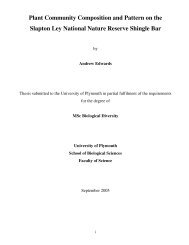de Vere 2007 Biol Flora C. dissectum.pdf - The Whitley Wildlife ...
de Vere 2007 Biol Flora C. dissectum.pdf - The Whitley Wildlife ...
de Vere 2007 Biol Flora C. dissectum.pdf - The Whitley Wildlife ...
- No tags were found...
You also want an ePaper? Increase the reach of your titles
YUMPU automatically turns print PDFs into web optimized ePapers that Google loves.
886N. <strong>de</strong> <strong>Vere</strong>greater productivity had higher seed production andpercentage germination was greater un<strong>de</strong>r greenhouseconditions. <strong>The</strong>se factors should allow greater colonizationcapacity of nearby sites but this will only bepossible if there are safe sites for seedling establishment;other research suggests that this is very rarely thecase (see sections VI(C) and VIII(D)). Seed dispersalability <strong>de</strong>creased with greater productivity, reducingthe possibility of longer distance dispersal.(C) EFFECT OF FROST, DROUGHT, ETC.Cirsium <strong>dissectum</strong> is found in moist habitats, althoughsome of its sites such as the heaths of the New Forest,Culm grasslands of south-west England, well-drainedSchoenus fens on limestone and sand-dune slacks willdry out to an extent during the summer. Ross (1999)showed that plants grown in growth-room conditionswere able to survive more than 32 h but less than 64 h ina post-wilting state but that this had a negative impacton relative growth rate (see section VI(E)(ii)). It thereforeseems likely that C. <strong>dissectum</strong> can survive limitedperiods of summer drought even though it will affectsubsequent growth.(C) PERENNATION: REPRODUCTIONCirsium <strong>dissectum</strong> is a long-lived perennial; in productivesites it can flower in its second year at the earliest.Rosettes die after flowering, but generally plantsreproduce vegetatively before this.Survival and growth of seedlings in the field is veryrare and clonal propagation is the dominant form ofreproduction (Jongejans 2004; Jongejans et al. 2006b).In a 5-year study of three grasslands in the Netherlands,Jongejans (2004) found only three seedlings. SimilarlyKay & John (1994) and <strong>de</strong> <strong>Vere</strong> (<strong>2007</strong>) found noseedlings in their surveys of populations in the BritishIsles. <strong>The</strong> low number of seedlings is caused primarilyby very low establishment rates in vegetation stands(Jongejans et al. 2006b; <strong>de</strong> <strong>Vere</strong> <strong>2007</strong>), as seedlings aremore abundant in restoration areas where the topsoil has been removed near C. <strong>dissectum</strong> populations(Jongejans 2004).(D) CHROMOSOMESMaterial from Port Ellen, Islay was found to be 2n = 34(Morton 1977).© <strong>2007</strong> <strong>The</strong> AuthorJournal compilation© <strong>2007</strong> BritishEcological Society,Journal of Ecology,95, 876–894VI. Structure and physiology(A) MORPHOLOGYCirsium <strong>dissectum</strong> has a hemi-cryptophyte basal rosettegrowth form. It typically produces new rosettes at theend of long rhizomes but new rosettes can also beformed at the base of existing ones. Rhizomes are a palestraw colour and smooth, with small brown scales atthe no<strong>de</strong>s. Rhizome lengths vary, from close to the parentplant to up to 40 cm, and they grow in a downwardcurve through the soil, seemingly unaffected by rootsor tussocks of other species or soil type (Jongejans2004). After 2 years, plants have produced a large cau<strong>de</strong>x,approximately 10 × 2 cm (<strong>de</strong> <strong>Vere</strong> <strong>2007</strong>). Jongejans(2004) investigated the relationships between rosettesize, flowering probability, rhizome formation andsite characteristics within five grasslands in theNetherlands. <strong>The</strong> number of rhizomes produced by aplant varied from 0 to 5 and was generally positivelycorrelated with its cau<strong>de</strong>x weight; cau<strong>de</strong>x weight inturn was positively correlated with site productivity.<strong>The</strong> most productive grassland had the greatestpercentage of rosettes that flowered; flowering rosetteshad heavier caudices than vegetative rosettes andproduced more rhizomes. Rhizome length and <strong>de</strong>pthdid not differ systematically between sites.(B) MYCORRHIZAArbuscular mycorrhizas are found, with the youngestfine roots being the most heavily colonized and ol<strong>de</strong>rroots having very little <strong>de</strong>tectable arbuscule <strong>de</strong>velopment(Ross 1999).(E) PHYSIOLOGICAL DATA(i) Response to sha<strong>de</strong>Ross (1999) compared relative growth rate in C. <strong>dissectum</strong>and Helianthus annuus at two light levels, 350 and150 µmol m –2 s –1 photon flux <strong>de</strong>nsity, in a growth roomwith a 16 h day at 22 °C and 15 °C night. Plants weregrown in conical flasks containing Rorison nutrientsolution. <strong>The</strong> mean relative growth rate was 0.063 g g –1day –1 for C. <strong>dissectum</strong> and 0.125 g g –1 day –1 for H. annuusat the higher light, and 0.055 g g –1 day –1 for C. <strong>dissectum</strong>and 0.105 g g –1 day –1 for H. annuus at the lower light;Ross (1999) conclu<strong>de</strong>d that C. <strong>dissectum</strong> was relativelytolerant of sha<strong>de</strong>. Ellenberg (1988) gave C. <strong>dissectum</strong> alight indicator value of 7, representing a species ofwell-lit places that also occurs in partial sha<strong>de</strong>, but Hillet al. (1999) gave C. <strong>dissectum</strong> within Britain a lightindicator value of 8, representing a light-loving plantrarely found where relative illumination in summer isless than 40%.(ii) Water relationsRoss (1999) investigated water uptake and water-useefficiency using a gravimetric method; plants weregrown in conical flasks containing Rorison nutrientsolution and the use of water <strong>de</strong>termined by weighingthe plants and the conical flasks containing thesolutions at regular intervals. Helianthus annuus wasalso grown so that the water use of this mesophyticspecies could be compared to C. <strong>dissectum</strong>. <strong>The</strong>experiment was carried out in a growth room with a16 h day at 22 °C and 15 °C night with day-time light




